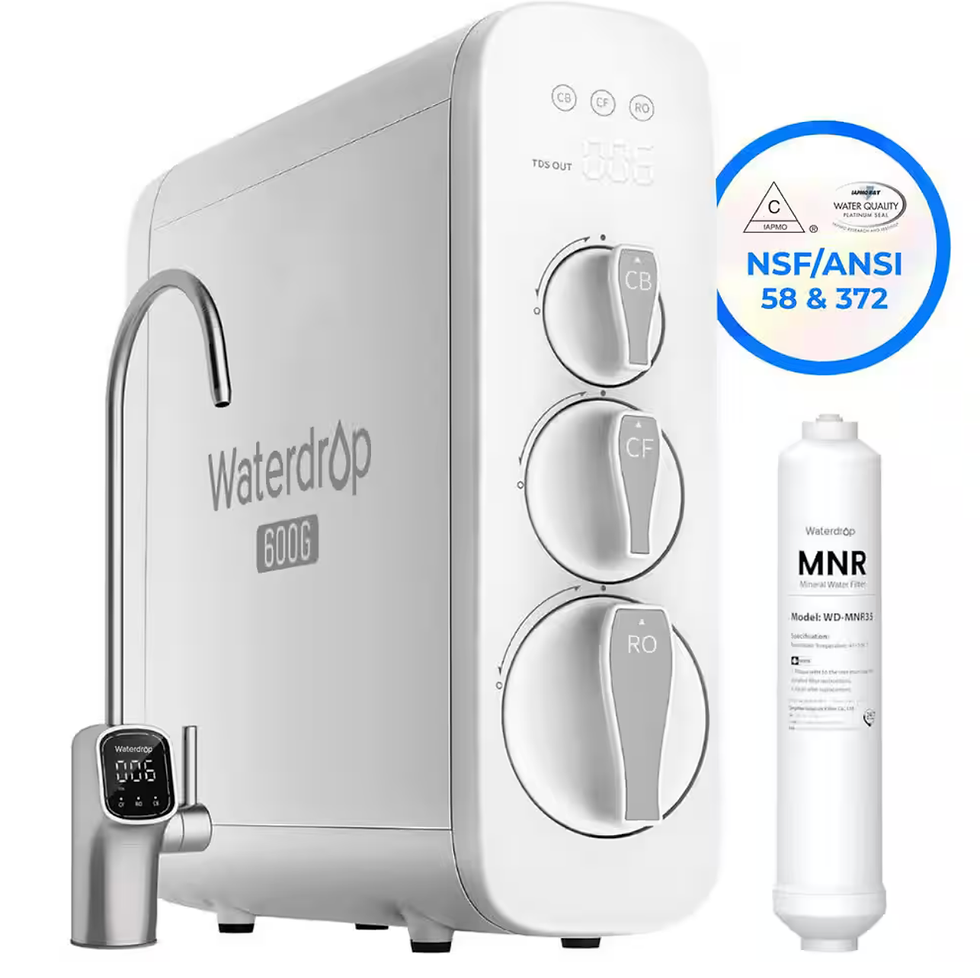Why Reverse Osmosis is Important for Every Household in South Florida
- Ilya Burtsev
- Oct 6
- 3 min read

Living in South Florida means dealing with heat, humidity, and water that often carries a mixture of minerals, chlorine, chloramine, and other contaminants. Whether your source is a municipal supply or a private well, reverse osmosis (RO) can be a game-changer for your home’s drinking water. Here’s why every homeowner here should consider it.
1. Superior Removal of Harmful Contaminants
Reverse osmosis systems force water through a semi-permeable membrane, blocking many dissolved solids, heavy metals, chemicals, and even some microorganisms. Studies and industry sources show RO systems can remove contaminants such as lead, arsenic, fluoride, chlorine, and other dissolved solids.
In South Florida, where water treatment often relies on chlorine and chloramine for disinfection, RO helps remove residual disinfectants (and their byproducts) that may remain in the water.
2. Better Taste, Odor & Water Quality
RO greatly improves the sensory quality of your water. Removing chlorine, chloramine, and dissolved impurities results in crisper, cleaner-tasting water with no chemical aftertaste.
This means no more reliance on bottled water or pitcher filters for drinking and cooking — every glass can be refreshing and pure.
3. Health & Safety Benefits
Reduced heavy metals & toxins: RO helps protect against long-term exposure to lead, arsenic, and other harmful elements.
Lower sodium & unwanted minerals: For households sensitive to sodium or needing low-mineral water, RO provides control over dissolved mineral content.
Safe water for vulnerable populations: Babies, elderly, or immunocompromised family members benefit from safer, cleaner water.
However, it’s worth noting that RO can strip beneficial trace minerals too, so balance is important.
4. Saves Money & Reduces Waste (Long-Term)
Switching to RO means fewer purchases of bottled water, which adds up over months and years.
Additionally, RO systems reduce scaling and dissolved solids in your cooking and plumbing appliances, which helps them operate more efficiently and last longer.
Be aware: RO systems do generate wastewater (reject water) during filtration.
Choosing a more efficient RO model (e.g. WaterSense-rated or modern systems) helps minimize that waste.
5. Perfect for South Florida Conditions
Soft water + RO: While much of Florida has “soft” water due to aquifer chemistry, combining RO with proper pre- and post-treatment ensures water purity without over-softening.
Protects against coastal or salt intrusion: In some coastal zones, there’s risk of saltwater intrusion or elevated dissolved solids — RO helps manage that.
Chlorine/chloramine overload: Many municipal systems in South Florida use chloramine; RO helps mitigate byproduct risks and residuals.
Implementation Tips & Considerations
Pre-treatment is key: Use sediment and carbon filters before the RO membrane — these protect the membrane from chlorine, particulate damage, and fouling.
Membrane & filter replacement: Maintain the system regularly; membranes may last a few years, pre-filters more frequently.
Remineralization stage: If desired, install a remineralization or blending stage so your water retains some beneficial minerals and a balanced pH.
Water efficiency: Choose high-efficiency RO units to reduce waste.
Sizing & capacity: Make sure the system is sized for your household’s drinking and cooking water demands.
Common Myths About Reverse Osmosis — Debunked
Myth 1: Reverse Osmosis Wastes Too Much Water
Modern RO systems are far more efficient than older models. Many now recover 3–4 gallons of pure water for every gallon of wastewater, and some even reuse that reject water for non-drinking purposes like irrigation.
Myth 2: RO Water Removes All Minerals and Is Unhealthy
While RO does remove most dissolved minerals, the same is true for bottled water brands. Most systems today include a remineralization stage that restores essential minerals like calcium and magnesium—keeping the water balanced and healthy.
Myth 3: Bottled Water Is Better Than RO Water
In reality, bottled water often comes from the same municipal sources and is filtered using reverse osmosis before bottling. Having an RO system at home gives you the same purity without plastic waste or recurring costs.
Myth 4: Reverse Osmosis Systems Are Hard to Maintain
Maintenance is simple—usually just replacing pre-filters once or twice a year and the main membrane every 2–3 years. Core Plumbing offers professional service plans to keep your system performing at its best.





Comments